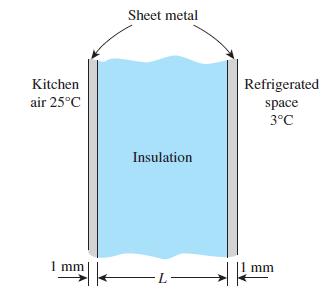Reconsider Prob. 335. Using EES (or other) software, investigate the effects of the thermal conductivities of the
Question:
Reconsider Prob. 3–35. Using EES (or other) software, investigate the effects of the thermal conductivities of the insulation material and the sheet metal on the thickness of the insulation. Let the thermal conductivity vary from 0.02 W/m·K to 0.08 W/m·K for insulation and 10 W/m·K to 400 W/m·K for sheet metal. Plot the thickness of the insulation as the functions of the thermal conductivities of the insulation and the sheet metal, and discuss the results.
Data From Problem 35
The wall of a refrigerator is constructed of fiberglass insulation (k = 0.035 W/m·K) sandwiched between two layers of 1-mm-thick sheet metal (k = 15.1 W/m·K). The refrigerated space is maintained at 3°C, and the average heat transfer coefficients at the inner and outer surfaces of the wall are 4 W/m2·K and 9 W/m2·K, respectively. The kitchen temperature averages 25°C. It is observed that condensation occurs on the outer surfaces of the refrigerator when the temperature of the outer surface drops to 20°C. Determine the minimum thickness of fiberglass insulation that needs to be used in the wall in order to avoid condensation on the outer surfaces.
Step by Step Answer:

Heat And Mass Transfer Fundamentals And Applications
ISBN: 9780073398181
5th Edition
Authors: Yunus Cengel, Afshin Ghajar




